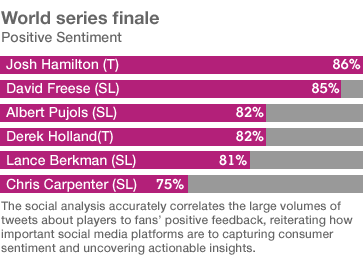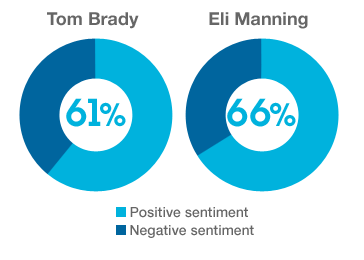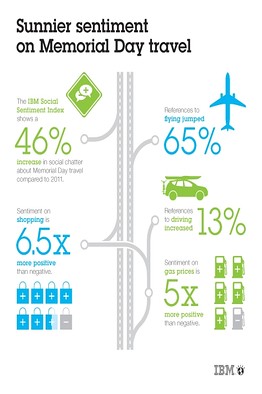

People in the U.S. are feeling better about the coming Memorial Day weekend than they did a year ago, according to an IBM study. As a result they may have bigger travel and shopping plans for the unofficial kickoff of the summer road-trip and vacation season.
Through an analysis of social media sentiment IBM found a significant increase in the number of people talking about travel and spending. The IBM Social Sentiment Index, uses analytics and language processing technology to identify and gather consumer opinions from Twitter, blogs, message boards and other social media.
According to the index conversations about Memorial Day travel increased by 46% compared to 2011. This suggests travel providers could see a boost in business and transportation officials will have to deal with more traffic. The index also shows a 65% rise in people mentioning traveling by air while discussion of driving increased 13%.
IBM said consumer sentiment regarding gasoline prices is surprisingly positive considering the average price of a gallon of regular gas, while 13 cents lower than a year ago, is still high at $3.71 according to the U.S. Energy Information Administration. Social media showed a five-to-one ratio of positive to negative mentions about gas in 2012 compared to a one-to-one ratio in 2011. These trends may indicate people are more confident about their finances this year.
Retailers also could see more spending by consumers over the holiday. The Index, which looked at online conversations from Jan. 1 to May 16 during 2012 and 2011, revealed a ratio of positive to negative comments about shopping — which IBM calls the Desire Ratio — is 6.5 to 1 this year compared to a ratio of 1.3 to 1 in 2011. During the same period, negative comments about budgets decreased by 50%.
“When analytics are applied to social media conversations, it identifies more than what people are talking about. This is valuable insight into people’s preferences and attitudes about a product or a service and helps us understand why people do what they do,” said Marty Salfen, IBM general manager, travel & transportation
An eye on the Twitterverse is an ear to the ground
The prevalence of social media means organizations have access to an unfiltered voice ripe for analysis. This requires new marketing approaches, tools and skills to effectively reach customers due to rising online, mobile and social trends. Businesses, academics and journalists can use analytics to gain new insights into consumer perceptions via social media—determining product placement, launch dates and market reception in a quicker, more efficient manner than focus groups or panels.
Professor Jonathan Taplin, director of the Annenberg Innovation Lab, sees potential for students and businesses alike using social sentiment analysis. "The work we are doing with IBM enables our students a unique opportunity to gain valuable knowledge in the use of advanced analytics technologies," he said, "and apply it to real-world settings to understand how this new information can benefit a variety of industries."
In particular, these tools can be used by retailers and sports franchises to better measure and understand consumer sentiment toward products, services and athletes. The idea is similar to a Q rating, or what IBM has dubbed a ‘T Score’ (Twitter score), that takes brand measurement one step further. By gaining real-time insights into customer and fan preferences news organizations and product marketers can use social media to improve how they serve their respective constituents.
A recent IBM global study of more than 1,700 chief marketing officers revealed that most of the world’s top marketing executives recognize a critical and permanent shift occurring in the way they engage with their customers. And Forrester Research estimates that market opportunity for social software is expected to exceed US$6 billion dollars by 2016, increasing 60 percent each year since 2010. 2
Analyzing social sentiment
Turn tweets into intelligence
Thanks to Twitter, 140 little characters can make a big impression. Today, those public tweets are pixels in a very big picture. And students at the Annenberg Innovation Lab at the University of Southern California (link resides outside of ibm.com), working with IBM, have turned that picture into meaningful data with a Social Sentiment Index.
The lab was established in 2010 to conduct student-led research that advances new techniques for communications and journalism.
he collaboration is aimed at broadening student skills in analytics and demonstrating how Watson-like technologies, such as sophisticated semantic and linguistic analysis software, can crunch Big Data in real-time. Students at define the areas of research and then use IBM’s technology to explore how these capabilities can be used by organizations from news outlets and journalists, movie studios and film marketers, retailers and branding experts, in order to better understand, respond and predict public preferences.
The Social Sentiment Index is one such initiative that uses Twitter. With an estimated 155 million tweets per day as of mid-2011, the micro-blogging platform is an excellent tool for sentiment analysis1.
The Index uses IBM analytics technology to analyze millions of public tweets, with the goal of creating real-time public opinion snapshots. They transform 140 characters from raw, unstructured data into valuable insights, gauging sentiment and following trends on a variety of topics from the retail, sports and entertainment, including major events like the World Series, the Super Bowl and the Academy Awards.
With this real-time analysis, the data churn is fast. A tweet goes out and, micro-seconds later, the sentiment is measured. IBM and USC are even using the new technologies to distinguish irony and apply "machine learning" to figure out which tweets are just background noise—and which truly count.




